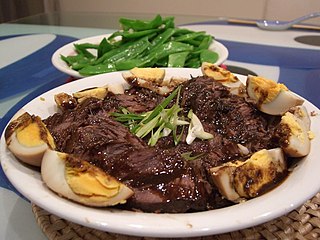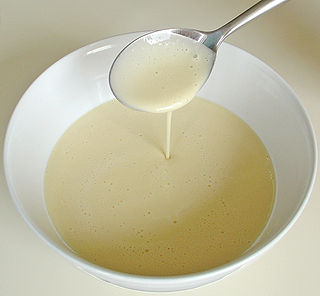
Cantonese or Guangdong cuisine, also known as Yue cuisine is the cuisine of Guangdong province of China, particularly the provincial capital Guangzhou, and the surrounding regions in the Pearl River Delta including Hong Kong and Macau. Strictly speaking, Cantonese cuisine is the cuisine of Guangzhou or of Cantonese speakers, but it often includes the cooking styles of all the speakers of Yue Chinese languages in Guangdong. Scholars categorize Guangdong cuisine into three major groups based on the region's dialect: Cantonese, Hakka and Chaozhou cuisines.

Fortified wine is a wine to which a distilled spirit, usually brandy, has been added. In the course of some centuries, winemakers have developed many different styles of fortified wine, including port, sherry, madeira, Marsala, Commandaria wine, and the aromatised wine vermouth.

French cuisine is the cooking traditions and practices from France. In the 14th century, Guillaume Tirel, a court chef known as "Taillevent", wrote Le Viandier, one of the earliest recipe collections of medieval France. In the 17th century, chefs François Pierre La Varenne and Marie-Antoine Carême spearheaded movements that shifted French cooking away from its foreign influences and developed France's own indigenous style.

Vermouth is an aromatized fortified wine, flavoured with various botanicals and sometimes colored. The modern versions of the beverage were first produced in the mid to late 18th century in Turin, Italy. While vermouth was traditionally used for medicinal purposes, it was later served as an apéritif, with fashionable cafés in Turin serving it to guests around the clock. In the late 19th century, it became popular with bartenders as a key ingredient for cocktails, such as the martini, the Manhattan, the Rob Roy, and the Negroni. In addition to being consumed as an apéritif or cocktail ingredient, vermouth is sometimes used as an alternative to white wine in cooking.

Braising is a combination-cooking method that uses both wet and dry heats: typically, the food is first browned at a high temperature, then simmered in a covered pot in cooking liquid. It is similar to stewing, but braising is done with less liquid and usually used for larger cuts of meat. Braising of meat is often referred to as pot roasting, though some authors make a distinction between the two methods, based on whether additional liquid is added. Osso buco and coq au vin are well known braised meat dishes, and the technique can also be used to prepare fish, tempeh, tofu or fruits and vegetables.

Coq au vin is a French dish of chicken braised with wine, lardons, mushrooms, and optionally garlic. A red Burgundy wine is typically used, though many regions of France make variants using local wines, such as coq au vin jaune (Jura), coq au riesling (Alsace), coq au pourpre or coq au violet, and coq au Champagne.

Ukrainian cuisine is the collection of the various cooking traditions of the people of Ukraine, one of the largest and most populous European countries. It is heavily influenced by the rich dark soil (chernozem) from which its ingredients come and often involves many components. Traditional Ukrainian dishes often experience a complex heating process – "at first they are fried or boiled, and then stewed or baked. This is the most distinctive feature of Ukrainian cuisine".

Flambé is a cooking procedure in which alcohol is added to a hot pan to create a burst of flames. The word means "flamed" in French.

In South Africa, a potjiekos, literally translated "small-pot food", is a dish prepared outdoors. It is traditionally cooked in a round, cast iron, three-legged cauldron, the potjie, descended from the Dutch oven brought from the Netherlands to South Africa in the 17th century and found in the homes and villages of people throughout southern Africa. The pot is heated using small amounts of wood or charcoal or, if fuel is scarce, twisted grass or even dried animal dung.

The following outline is provided as an overview of and topical guide to food preparation:
Sierra Leonean cuisine consists of the cooking traditions and practices from Sierra Leone. It follows the traditions of other West African cuisines. The country has 16 tribal ethnic groups.

West African cuisine encompasses a diverse range of foods that are split between its 16 countries. In West Africa, many families grow and raise their own food, and within each there is a division of labor. Indigenous foods consist of a number of plant species and animals, and are important to those whose lifestyle depends on farming and hunting.
Sociology of food is the study of food as it relates to the history, progression, and future development of society. This includes production, distribution, conflict, medical application, ritual, spiritual, and cultural applications, environmental and labor issues.

Korean barbecue is a popular method in Korean cuisine of grilling meat, typically beef, pork or chicken. Such dishes are often prepared on gas or charcoal grills built into the dining table itself. Some Korean restaurants that do not have built-in grills provide customers with portable stoves for diners to use at their tables. Alternatively, a chef uses a centrally displayed grill to prepare dishes that are made to order.

Awadhi cuisine is a cuisine native to the Awadh region in Northern India. The cooking patterns of Lucknow are similar to those of Central Asia, the Middle East, and Northern India with the cuisine comprising both vegetarian and non-vegetarian dishes. The Awadh region has been greatly influenced by Mughal cooking techniques, and the cuisine of Lucknow bears similarities to those of Central Asia, Kashmir, Punjab and Hyderabad. The city is also known for its Nawabi foods.

The idea of drinking whisky with food is considered outré by many, but there is a growing interest in pairing whiskies with complementary foods. The Scotch whisky industry has been keen to promote this. Single malts, pot-still whiskies, bourbons, and rye whiskies offer an interesting range of tastes and aromas, which are just as varied as wine. Jake Wallis Simons compares whiskies in bourbon casks to white wines, due to their lighter flavor, and those in sherry casks to red wines, with their greater fruitiness. A few Scottish cook books contain reference to the use of whisky in cooking, and a few traditional Scottish recipes that use whisky exist.
An aromatised wine is a fortified wine or mistelle that has been flavoured with herbs, spices, fruit or other natural flavourings.

Batter is a flour mixture with liquid and other ingredients such as sugar, salt and leavening used for cooking. It usually contains more liquid than doughs, which are also mixtures of flour and liquid. Batters are usually a pourable consistency that can't be kneaded. Batter is most often used for pancakes, light cakes, and as a coating for fried foods. It is also used for a variety of batter breads.
















